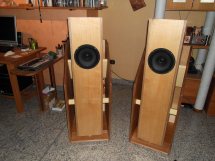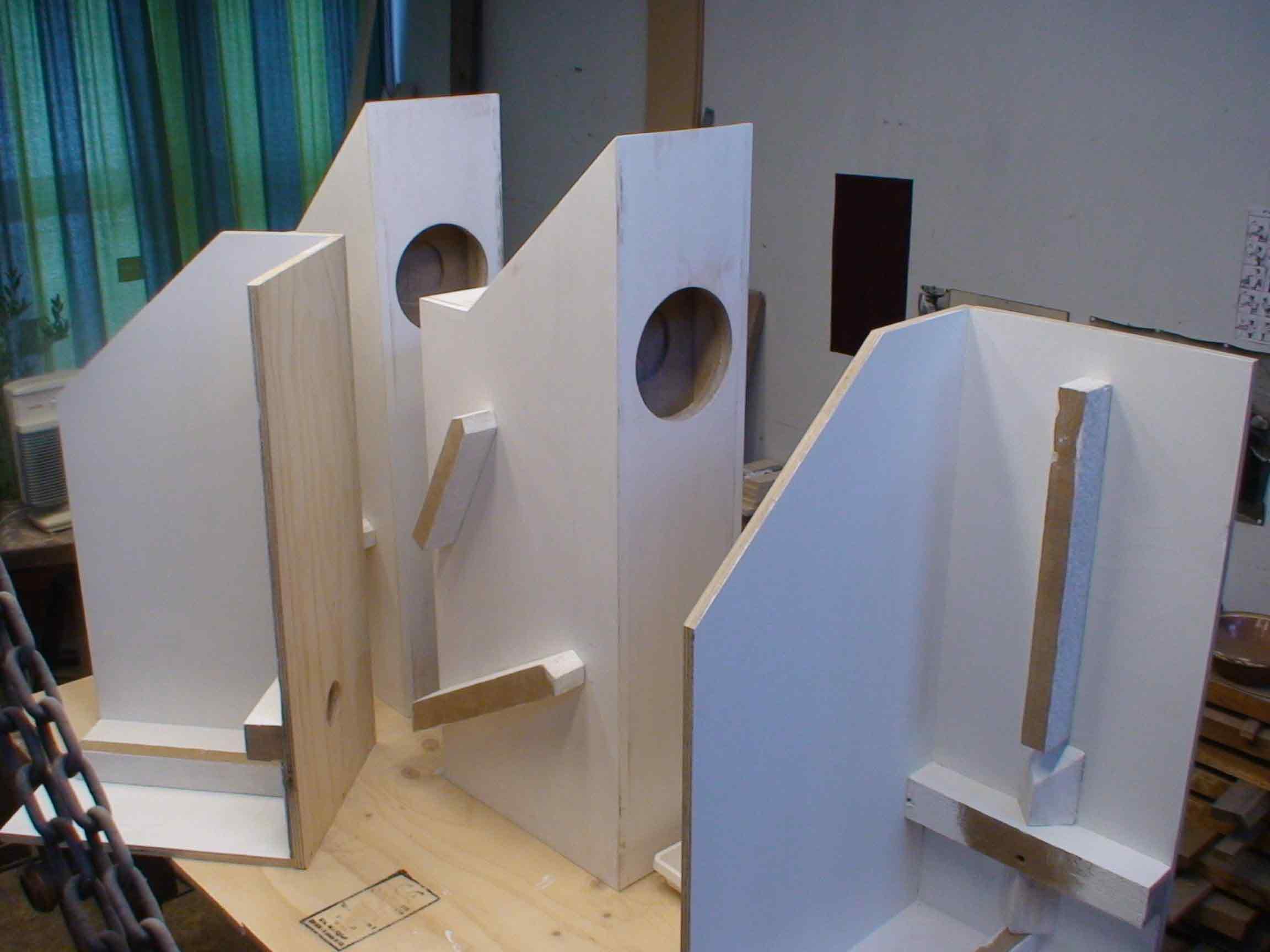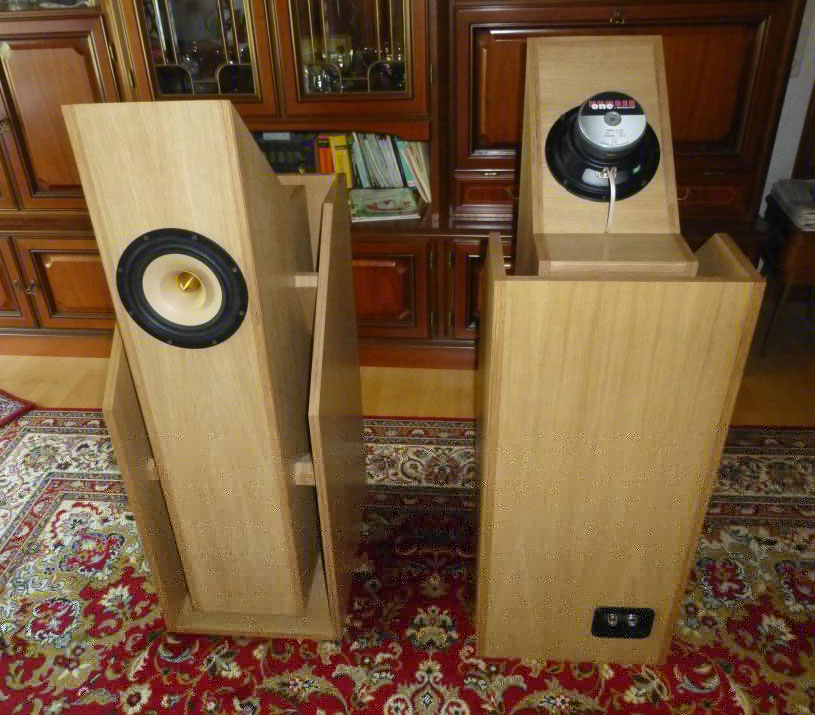RDH20
Messungen / measurements
feedback
plan
.
Hello,
I was in Hamburg for business and decided to meet Horst for a listening.
Very nice and valid. They sounded good driven with common amplification
and nothing special. They produce good bass for their size. It was deep
and controlled and there was no reasonance whatsoever.
I bought the designs for the saxophone but I think I`ll eventually build these.
Thanks again Horst!
Tschuss!
http://www.diyaudio.com/forums/full-range/140498-frame-double-horn-two-8-a.html
.

hier nun das versprochene Feedback. Eigentlich kann
man´s nicht beschreiben , aber ich versuche es mal.
Nach dem ersten Test lud ich meine Geschwister ein --
einer meiner Brüder ist studierter Musiker (Klassik)
der muss es ja wissen bzw. hören.
Egal was man sich anhört Michael Jackson, Pink Floyd,
ABBA, Rock`N`Roll, Lionel Richie, Barry White,
Cat Stevens, Klassik, Simply Red, Simon&Garfunkel,
einfach jede Musikrichtung:
Der Klang Glasklar, Bass mit druck- Höhen- Tiefen
alles hörbar einfach nur Gänsehautfeeling
man muss es gehört haben.
Am Besten baut man sich so ein Horn selbst ich
jedenfalls habe es nicht bereut, auch meine
Kumpel waren begeistert, vielen vielen Dank
für diesen genialen Bauvorschlag.
sehr schön von Herrn M., gekürzt

.

sehr gut !
besser als
mein Prototyp,
Gratulation !
Conclusion from Margaretha at Helsingborg.
The first thing I did was to saw out all the pieces out of the different kinds of boards.
In the beginning I thought it was fun because I was just starting the project and I was
planning on doing everything just perfect. But when I was done with first ten pieces it
wasn´t fun anymore. I didn´t have choice so I just continued to saw and after some time
I got really tired of sawing, so when it was time for the other step which was to glue all the
soft board pieces onto the inside of the plywood box I was happy. It was fun because it
changed all the time and I wasn´t doing the exact same thing all the time. I also had to think
more because almost every time I glued a soft board piece onto the inside of the plywood
board box I couldn´t use the screw clamps so I had to come up with other ways to make the
soft board pieces stay still so that they could stuck.
I think that the final project was much better than the original goal. They look much nicer
then I thought they were going to look. They also sound way better than I thought they
would, especially when I compare them to my old loudspeakers. They work so I´m very
happy with result of the project.
The AoI that I choose was Human ingenuity. During my project I saw that esthetics and
technique is very close connected and now I know that without technique there would
almost never be any esthetics. I also realized that the most effective way of getting
something you really want to have is to do it yourself. If I would by these horn loudspeakers
in a store they would cost a lot but by making them myself they didn´t cost much at all.
Also by making them myself I decided how I wanted them to look on the outside.
I could have tackled the project differently by making a more specific plan, but even though
I made a plan it wasn´t easy to follow because somethings took a lot longer than planned.
I also could have done some things more in detail; like for example the measuring and checking
the degrees a little bit more often.
The impact this project had on me is very positive. Thanks to this project I´ve been more
interested in music and I´ve learned a lot, not just about music but also about technique.
When I listen to my horn loud speakers I feel like I just want to pick up the guitar and play
or just sing along to the music they are playing. The sound is very clear and pleasant to listen
to and I don´t regret a second of the time I spent building them.

Mit B200 und
nicht invers BG20
nicht verpolt nur
parallel, ein
Sperrkreis
scheint nicht
notwendig zu sein.
.
hier nun endlich das versprochene Feedback zum Onkel-Neffe-Projekt "Bau der RDH20".
Alles startete im Frühjahr 2013 mit der Recherche der verschiedenen Lautsprechertypen und
konkreter Lautsprecherboxen. Dabei stießen wir auf Sie und auf Ihr RDH20.
Im Mai 2013 hatten wir dann die Gelegenheit, das RDH20 bei Ihnen Probe zu hören.
Nach einer kurzen Beratung war schnell klar: Die soll es werden.
Anhand Ihrer ausführlichen Teileliste kauften wir dann im Anschluss noch
die notwendigen Multiplex- und Weichfaserplatten.
Wir unterschätzten allerdings den für uns notwendigen Zeitaufwand --Mit dem nächsten Urlaub über den Jahreswechsel 2013/2014 nahm das Projekt an Fahrt auf, und nach diversen Wochenenden -- konnten wir dann endlich am 19. Juli 2014 das Ergebnis Probe hören.
Und ich kann sagen, wir standen beide mit einem sehr breiten Grinsen da. Inzwischen stehen die Lautsprecher im Zimmer meines Neffen.Bei der Bestückung entschieden wir uns vorne für den Breitbandlautsprecher "Tang Band W8-1772" und hinten für den Tiefmitteltöner "Monacor SPH-210". Diesen installierten wir invers und verpolt. Zurzeit verwenden wir keinen Sperrkreis - es gibt auch noch keine Veranlassung, das zu ändern.
Unseren Hörtest starteten wir, wie schon beim Probehören, mit CDs durch alle Musikrichtungen: Abba, Joe Cocker, Phil Collins, Dire Straits, Peter Gabriel, Marla Glen, Michael Jackson, Jean Michel Jarre, Led Zeppelin, Motörhead, Nightwish, Mike Oldfield, Rammstein, Simple Minds, Supermax, Swedish House Mafia, Technotronic, Unheilig, Within Temptation, Yello, um nur einige wenige zu nennen, gefolgt von Titeln aus den Italo-Disco-, Pop-&-Wave- sowie Rock-&-Pop-Charts. Weiter mit klassischer Musik, mit Klaviermusik von Yul Anderson und Orgelmusik von Johann Sebastian Bach. Am Ende dann Trance, Techno und Hardstyle.
Einfach gigantisch dieser klare Klang und die tolle Auflösung.
War ich anfangs vor dem Bau noch etwas skeptisch, was Schalldruck und Tiefbass aus einem kleinen 20cm-Breitbänder angeht, so wurden wir doch deutlich eines Besseren belehrt: Steht man unmittelbar vor der Box, so kommt das am Ohr an, was man von einem 20cm-Treiber erwartet. Tritt man dann mindestens einen bis anderthalb Meter zurück, dann schlagen die beiden Hornkanäle zu - sowohl was Tiefbass als auch was Schalldruck angeht; ganz besonders natürlich bei modernen "optimierten" CD-Aufnahmen aber auch bei alten CD-Aufnahmen.
Das machte beim Probehören einfach nur Gänsehaut und ein "Mehr davon", welches Stück wollen wir jetzt noch hören?
Auch wenn wir anfangs unseren Aufwand doch erheblich unterschätzt haben, so waren es tolle gemeinsame Stunden, an die wir uns sicherlich noch lange zurückerinnern werden. Die eigentliche Belohnung erfolgt am Ende durch den Wahnsinnshörgenuss mit diesen Lautsprechern.
So kann unser Fazit nur lauten - wir würden diese Box sofort wieder bauen. Wir können uns anderen nur anschließen - vielen Dank für diesen genialen Bauvorschlag.
sehr gut, vielen Dank an Yannic+Onkel Christian, gekürzt.

.
Noch immer juckt meine Kopfhaut.
Das kann einfach nicht wahr sein, daß es einer einzelnen, in der "HiFi-Welt" mehr oder minder
unbedeutenden Person es in seiner Leidenschaft für Lautsprecher-Horn Konstruktionen gelingt,
aus einem Paar selbstkonstruierter Lautsprecher mit einem Materialwert von ca. 500€
(davon 350€ für Multiplex, Kleber und Sonofil) einen solchen Sound zu zaubern!
Eine solch homogene Bühne, so natürlich, so direkt und life, so weich und schmeichelnd im
Hochton und gleichermaßen so abgrundtief schwarz und direkt im Tieftonfundament,
so "easy-going", habe ich selten erlebt.
vielen Dank von Rudi R.
.
-- Horst is the creator of a wide range of backloaded horn designs,
which has earned him both fans and critics. He certainly has a
respectable career, with several of his designs featured in the
leading German DIY audio magazines and others interesting enough
to manufacturer Visaton to test in their own facilities. --
Horst prepared a piece of text for me, about the use of different materials
to construct horns from. Horst advocates the use of soft fiberboard, to make
enclosures with excellent internal damping. --
A new thing he put forward, was that the material dampens most sound
above 200 Hz, which ensures that few higher frequencies travel down the horn.
This creates a stronger crossover between the midrange (from the driver)
and the bass (from the horn).--
But Horst has done more than design relatively standard backloaded horns with soft
fiberboard. Since the earlier published designs, he has started to use double driver
configurations, dual horns, different pathlengths to achieve smooth response in small
volumes, bipole -- configurations and creative space-using concepts (like horns
incorporated in seats). Very neat stuff. --
Some months ago, Horst released, which he calls the RDH20, or Rahmendoppelhorn
(double frame horn) for 20cm/8" drivers. --
It looks VERY exciting and, perhaps more importantly, VERY clear now,--
Some things to note about this design: There is a forward-firing and rear-firing driver. Depending on choices of the builder, the rear driver can be a woofer or a second fullrange driver. -- The two drivers drive two different horns, of different length and expansion.
The idea is that the horns have different peaks and dips and fill in each other's weak points. --
The inner horn rests on the outer section via a panel of soft fiberboard, which decouples it.
Also notice how the horn mouth is wrapped around the entire enclosure. It is relatively large,
yet the enclosure the driver sees is relatively small.
Finally, I think it is a beautifully proportioned horn, which draws much less attention to itself
than some of Horst's other designs.
To his credit, and downfall, of most of his designs. He is criticized for strange and peaky/dippy response graphs, but I think they mostly show how tough it is to measure a smooth response in a room. He offers several measurements, from several drivers, measured in several positions. At the very least, the horn does bass. At best, it has response below 30 Hz. Also, he shows how the horns seems to dominate the response, not so much the driver parameters. This is something that people like Klinger also stated and Horst's measurements seem to support his.
gekürzt aus: http://hornloudspeakermagazine.blogspot.com/feeds/posts/default
copyright hm-moreart Horst Möller 2009